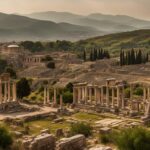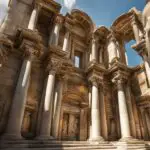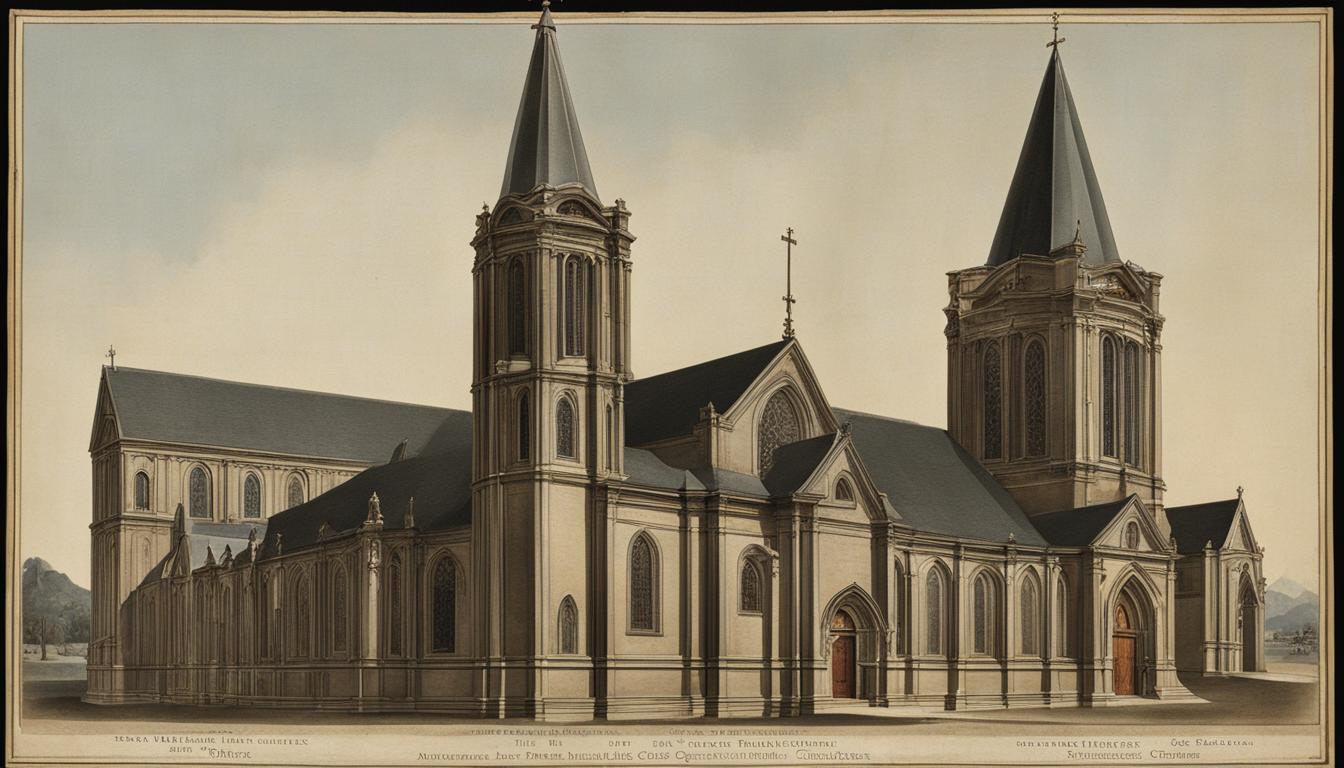Welcome to our in-depth exploration of the ancient church in Colossae. In this article, we will delve into the history and significance of this early Christian community, shedding light on its origins, beliefs, practices, and impact. Join us as we uncover the fascinating story of the church in Colossae and its enduring legacy.
Key Takeaways:
- The church in Colossae was founded in the first century AD and may have been established by Epaphras, a companion of the Apostle Paul.
- Paul’s letters to the Colossians and Philemon provide valuable insights into the beliefs and doctrines of the early Christian community in Colossae.
- The church in Colossae held historical significance as mentioned in the New Testament, highlighting the spread of Christianity in the first century AD.
- No specific information is available regarding denominational splits or schisms within the early church in Colossae.
- The exact leadership and governance structure of the church in Colossae remain unclear, but individuals like Epaphras and Philemon played significant roles.
Stay tuned as we continue our journey through the rich history of the church in Colossae, exploring its worship practices, contemporary influence, and more.
Origins and Founders of the Church in Colossae
The church in Colossae, an ancient city located in present-day Turkey, is believed to have been founded in the first century AD. While the exact circumstances of its establishment are not known, it is widely speculated that Epaphras, a friend and coworker of the Apostle Paul, played a significant role in its formation. Although Paul himself did not visit Colossae, he wrote two epistles addressed to the Colossians and mentioned the church in his letter to Philemon, indicating the presence of a thriving Christian community.
Epaphras, mentioned in Paul’s letters as a fellow laborer and a faithful minister of Christ, is often regarded as one of the key founders and leaders of the church in Colossae. His association with Paul suggests that he may have been influenced by Paul’s teachings and played an instrumental role in evangelizing and establishing the church.
While the specific details surrounding the origins of the church in Colossae are not definitively known, the evidence suggests that it emerged as a result of the early Christian missionary efforts and the influence of the Apostle Paul and his associates.
Table: Key Figures in the Origins of the Church in Colossae
| Name | Role |
|---|---|
| Epaphras | Possible founder and leader of the church |
| Paul | Indirectly contributed through his letters and teachings |
As the church in Colossae continued to grow and develop, it became an integral part of the early Christian movement, serving as a testament to the spread of Christianity in the region and beyond.
The next section will delve into the key beliefs and doctrines upheld by the church in Colossae, shedding light on the spiritual foundation of this ancient Christian community.
Key Beliefs and Doctrines of the Church in Colossae
The church in Colossae, like many early Christian communities, held to the core beliefs and doctrines of Christianity. While the specific details are not explicitly stated in the available sources, we can infer some of their key beliefs based on the teachings of the Apostle Paul in his letters to the Colossians.
One of the central beliefs held by the church in Colossae was the divinity of Jesus Christ. Paul emphasized the supremacy of Christ and his role as the head of the church. He wrote, “For in him all the fullness of God was pleased to dwell” (Colossians 1:19, ESV), highlighting the belief in Jesus as the Son of God and the embodiment of divine authority.
Additionally, the church in Colossae would have embraced the doctrine of salvation through faith. Paul wrote, “For by grace you have been saved through faith. And this is not your own doing; it is the gift of God” (Ephesians 2:8, ESV). This belief in salvation through faith in Christ would have been foundational to the teachings and practices of the church.
“For in him all the fullness of God was pleased to dwell.” – Colossians 1:19, ESV
“For by grace you have been saved through faith. And this is not your own doing; it is the gift of God.” – Ephesians 2:8, ESV
Additionally, the church in Colossae would have emphasized the importance of Christian virtues such as love, faith, and hope. Paul wrote, “And above all these put on love, which binds everything together in perfect harmony” (Colossians 3:14, ESV). This emphasis on virtuous living reflects the church’s commitment to embodying the teachings of Christ in their daily lives.
While specific details may be lacking, the church in Colossae shared in the foundational beliefs and doctrines of early Christianity, placing their faith in the divinity of Christ, salvation through faith, and the practice of Christian virtues.
Historical Significance of the Church in Colossae
The church in Colossae holds historical significance as it is mentioned in the New Testament as the recipient of two of Paul’s epistles. The letters to the Colossians and Philemon provide insights into the challenges faced by the early Christian community in Colossae and the teachings of Paul. These epistles not only highlight the existence of the church in Colossae but also shed light on the religious and cultural dynamics of the city during that time.
Paul’s letters to the Colossians contain warnings against false teachings and religious syncretism prevalent in Colossae. By addressing specific issues and doctrinal concerns, Paul’s words demonstrate the importance of the church in Colossae within the larger context of early Christianity. The struggles and triumphs of the Colossian church offer valuable lessons for believers throughout history, emphasizing the need for sound doctrine and a steadfast faith.
“For though I am absent from you in body, I am present with you in spirit and delight to see how disciplined you are and how firm your faith in Christ is.” – Colossians 2:5
The historical significance of the church in Colossae extends beyond the first century AD. The inclusion of Paul’s letters in the New Testament canon ensures that the experiences and teachings of the early Christian community in Colossae continue to be studied and valued by Christians worldwide. These epistles serve as a source of inspiration and guidance for believers seeking to navigate the challenges of their own faith journeys.
Table: Key Events and Correspondence Related to the Church in Colossae
| Event/Correspondence | Date |
|---|---|
| Founding of the Church in Colossae | First century AD |
| Epistle to the Colossians | Around 60-62 AD |
| Epistle to Philemon | Around 60-62 AD |
| Colossae’s Decline and Disappearance | Following the ancient city’s decline, no longer extant |
The church in Colossae, despite its eventual decline and disappearance, remains a significant part of the historical tapestry of early Christianity. Its inclusion in the biblical canon and the teachings contained within Paul’s letters ensure its enduring relevance for Christians seeking a deeper understanding of the faith and its origins.

Denominational Split or Schisms in the Church in Colossae
While the available historical sources do not provide specific information about denominational splits or schisms within the early church in Colossae, it is important to note that the church faced challenges related to false teachings and religious practices. In his letter to the Colossians, the Apostle Paul warns against deceptive philosophies and the empty traditions of human beings, emphasizing the need to hold fast to the truth of Christ (Colossians 2:8). This suggests that there may have been differing doctrines and beliefs influencing the church in Colossae, potentially leading to theological disagreements and tensions.
It is possible that the Colossian church grappled with the syncretistic tendencies of the city, where diverse religious beliefs were accepted and merged. The presence of various philosophical schools, local cults, and traditional practices may have created a fertile ground for differing interpretations and the emergence of conflicting factions within the church. However, without further historical documentation, it is challenging to ascertain the extent and nature of these schisms or denominational splits, as the focus of the available sources is primarily on Paul’s teachings and exhortations to the Colossians.
“See to it that no one takes you captive through hollow and deceptive philosophy, which depends on human tradition and the elemental spiritual forces of this world rather than on Christ.” – Colossians 2:8 (NIV)
| Denominational Splits or Schisms | Likelihood |
|---|---|
| Presence of differing interpretations of Paul’s teachings | Possible |
| Influence of syncretistic beliefs in the city | Possible |
| Evidence of conflicting factions within the church | Uncertain |
Without further historical evidence, it remains unclear whether the church in Colossae experienced significant denominational splits or schisms. However, the warnings from Paul regarding false teachings and the presence of diverse beliefs suggest that there may have been theological disagreements and factions within the Colossian church. The specific details and consequences of these potential divisions, however, are not expounded upon in the available sources.
Leadership and Governance of the Church in Colossae
The church in Colossae, like many early Christian communities, would have had a system of leadership and governance in place to guide and oversee its activities. While the specific structure of the church in Colossae is not explicitly mentioned in the available sources, it can be inferred that individuals such as Epaphras and Philemon played significant roles in leading and guiding the community.
Epaphras, mentioned by Paul as a coworker and friend, is believed to have been instrumental in establishing and leading the church in Colossae. His close association with Paul suggests a level of authority and responsibility within the community. Philemon, another individual mentioned in Paul’s letters, may have also held a position of leadership within the church.
It is possible that the church in Colossae followed a system of governance similar to other early Christian communities, where leaders were chosen based on their spiritual maturity, knowledge of the faith, and ability to teach and guide others. The early Christian church often relied on local leaders and elders to provide guidance and address issues within the community.
“These leaders would have been responsible for teaching and interpreting the Scriptures, encouraging spiritual growth, resolving disputes, and ensuring the overall well-being of the church in Colossae.”
In the absence of specific details, we can draw insights from the general practices of early Christian communities to understand the likely leadership and governance structure of the church in Colossae. These leaders would have been responsible for teaching and interpreting the Scriptures, encouraging spiritual growth, resolving disputes, and ensuring the overall well-being of the church in Colossae.
Worship Practices of the Church in Colossae
The worship practices of the church in Colossae are not explicitly described in the available sources, but we can make some reasonable assumptions based on the general practices of early Christian communities during that time.
It is likely that the church in Colossae gathered for regular worship, which would have included elements such as prayer, singing hymns, and the reading and teaching of Scripture. These practices were common among early Christian communities and served as a way to express devotion to God and foster spiritual growth.
Additionally, baptism and the Lord’s Supper were significant sacraments in early Christianity. Baptism symbolized the cleansing of sins and the initiation into the Christian faith, while the Lord’s Supper, also known as Communion, commemorated the Last Supper of Jesus and his disciples.
While specific details of the worship practices in Colossae may not be known, it is important to recognize the centrality of worship in the life of the early Christian community. It provided a space for believers to come together in fellowship, offer praise and thanksgiving to God, and deepen their faith through the study of Scripture and participation in sacraments.

Table: Comparison of Worship Practices in Early Christian Communities
| Element | Description |
|---|---|
| Prayer | Communal prayers were offered to God, both in individual and group settings. |
| Singing Hymns | Believers would join together in singing hymns of praise to God, expressing their devotion and gratitude. |
| Reading and Teaching Scripture | The Scriptures, including the Old Testament and early Christian writings, were read aloud and explained to the community for instruction and edification. |
| Baptism | New believers would undergo baptism as a public declaration of their faith and identification with Christ. |
| Lord’s Supper (Communion) | Believers would partake in the Lord’s Supper, sharing in the bread and wine as a remembrance of Jesus’ sacrifice and the establishment of the New Covenant. |
“Worship is not just an event; it is a lifestyle. It is a daily recognition of God’s greatness and a surrendering of ourselves to His will.” – Unknown
Contemporary Influence of the Church in Colossae
The church in Colossae, although no longer extant, holds historical significance and continues to have a contemporary influence. While the exact extent of its influence is difficult to determine, the early Christian community in Colossae left a lasting legacy that is valued and studied by Christians worldwide.

One of the most notable influences of the church in Colossae is the inclusion of the letters to the Colossians and Philemon in the New Testament. These epistles provide insights into the challenges faced by the early Christian community and the teachings of the Apostle Paul. As such, they continue to be studied and valued as a source of guidance and inspiration.
Furthermore, the existence of the church in Colossae highlights the spread of Christianity in the first century AD. Despite the city’s decline in importance over time and the movement of its population to nearby locations, the early Christian community played a significant role in the expansion of the faith.
While the specific details of the contemporary influence of the church in Colossae may remain uncertain, its historical significance and the continued study of its teachings contribute to the ongoing relevance and importance of the Colossae church in the broader Christian community.
Current Membership Number and Percentage of World Religions
The church in Colossae, although historically significant, is no longer in existence today. Therefore, it is not possible to provide an accurate current membership number for the church in Colossae. The lack of historical documentation and the decline of the city make it difficult to determine the size and influence of the Christian community in Colossae in relation to world religions.
Additionally, it is important to note that the world religious landscape has evolved significantly since the time of the early church in Colossae. Christianity, as a global religion, has grown and diversified, with various denominations and branches spreading across different continents and cultures. Therefore, attempting to quantify the membership of the church in Colossae in comparison to the current world religions would be speculative and not based on concrete data.
Instead of focusing on membership numbers, it is more meaningful to appreciate the historical significance of the church in Colossae and its impact on early Christianity. The inclusion of Paul’s letters to the Colossians and Philemon in the New Testament is a testament to the enduring legacy of the church and its teachings. These texts continue to be studied and valued by Christians worldwide, contributing to the ongoing theological conversations and understanding of the Christian faith.

Table: Comparison of World Religions
| Religion | Estimated Number of Adherents | Percentage of World Population |
|---|---|---|
| Christianity | 2.4 billion | 31.1% |
| Islam | 1.9 billion | 24.9% |
| Hinduism | 1.2 billion | 15.6% |
| Buddhism | 506 million | 6.6% |
| Judaism | 14 million | 0.2% |
| Other Religions | 1.2 billion | 16.6% |
| Unaffiliated/Non-Religious | 1.2 billion | 16.6% |
Note: The estimated number of adherents and the percentage of world population for each religion are approximations based on available data and may vary depending on different sources and methodologies. These numbers serve as a general representation of the global religious landscape and are subject to change.
Conclusion
The church in Colossae, a significant ancient Christian community, holds a unique place in early Christian history. Although the specific details of its origins, beliefs, and practices are not explicitly outlined in available sources, its existence and historical significance are unquestionable. The epistles of Paul addressed to the Colossians and Philemon serve as a testament to the presence and importance of this ancient church.
While the exact duration and current influence of the church in Colossae remain debated among scholars, its legacy as an early Christian community continues to be cherished and studied. The church played a crucial role in the spread of Christianity in the first century AD, providing insights into the challenges faced by early believers amidst a diverse religious landscape in Colossae.
Although there is no definitive historical documentation regarding denominational splits or schisms within the church in Colossae, the available sources mainly focus on theological and ethical issues addressed by Paul. It is plausible that the church remained relatively unified during its early years, but without further evidence, conclusive judgments regarding schisms are not possible.
The governing structure of the church in Colossae is not explicitly outlined in the available sources. However, individuals like Epaphras and Philemon, mentioned by Paul, likely played significant roles in its leadership and guidance. The presence of these early Christian leaders suggests an organized and dedicated community.
While specific worship practices of the church in Colossae are not detailed, it can be inferred that regular gatherings for worship, prayer, and the reading and teaching of Scriptures took place. The observance of baptism and the Lord’s Supper, as seen in other early Christian communities, could also have been part of their worship.
Although the contemporary influence of the church in Colossae cannot be accurately measured due to limited historical documentation and the city’s decline in importance over time, its historical significance endures. The inclusion of Paul’s letters to the Colossians and Philemon in the New Testament demonstrates the lasting impact of this ancient Christian community on the global religious landscape.
While it is not possible to provide an accurate current membership number or percentage of world religions for the church in Colossae, its legacy as an ancient church continues to be valued and studied. The church in Colossae stands as a testimony to the rich history and diverse beliefs within early Christianity.
FAQ
When was the church in Colossae founded?
The church of Colossae was founded in the middle of the first century AD, possibly by Epaphras, a friend and coworker of the Apostle Paul.
Who founded the church in Colossae?
The church in Colossae was possibly founded by Epaphras, under the influence of the Apostle Paul.
What are the key beliefs and doctrines of the church in Colossae?
The specific details of the beliefs and doctrines of the church in Colossae are not explicitly stated, but it can be inferred that they held to the core doctrines of Christianity, including the divinity of Jesus Christ, salvation through faith, and the importance of Christian virtues.
Why is the church in Colossae historically significant?
The church in Colossae holds historical significance as it is mentioned in the New Testament as the recipient of two letters from the Apostle Paul, which provide insights into the challenges faced by the early Christian community and highlight the spread of Christianity in the first century AD.
Were there any denominational splits or schisms in the church in Colossae?
There is no specific information available about denominational splits or schisms within the early church in Colossae.
Who were the leaders of the church in Colossae?
The specific leadership and governance structure of the church in Colossae are not explicitly mentioned, but individuals like Epaphras and Philemon are mentioned as having played significant roles in the leadership and guidance of the church.
What were the worship practices of the church in Colossae?
The specific worship practices of the church in Colossae are not described in detail, but it can be assumed that they gathered for regular worship, prayer, and the reading and teaching of Scriptures. Baptism and the Lord’s Supper were likely observed as significant sacraments.
What is the contemporary influence of the church in Colossae?
The contemporary influence of the church in Colossae is difficult to determine due to the lack of historical documentation after the first century AD. However, the legacy of the early Christian community in Colossae can be seen in the inclusion of Paul’s letters in the New Testament, which continue to be studied and valued by Christians worldwide.
What is the current membership number and percentage of world religions for the church in Colossae?
Due to the lack of historical documentation and the decline of the city of Colossae, it is not possible to provide an accurate current membership number or percentage of world religions for the church in Colossae.
















